
January 2020
I said I would give the Mountaineers a second chance after my disastrous North Fork Sauk River backpacking trip, and I did: I signed up for a snowshoe class. Before I signed up, I made sure to contact the class lead instructor to ensure I would not get left behind. The instructor assured me for the field trip, the class would be split into several groups, depending on anticipated pace. I should be able to keep up with the slower-paced group. Sounded good to me!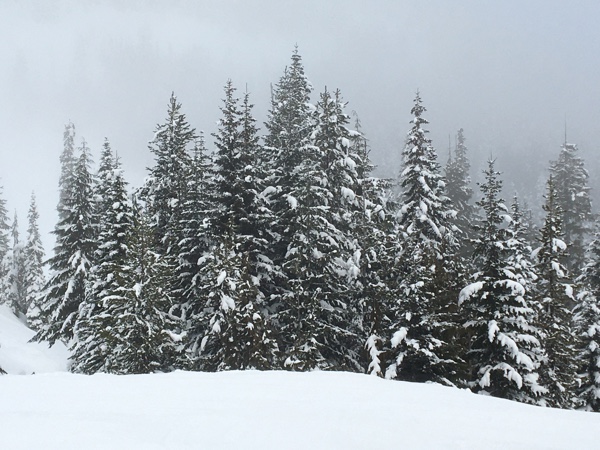
The class consisted of four two-hour classroom lectures and one full-day field trip to nearby White Pass. The lectures covered equipment for both snowshoeing and cross country skiing, clothing, trail etiquette, the ten essentials, and avalanche awareness. I am not new to either sport, so most of the information was not new to me. However, traveling in avalanche territory is. (Interesting reading: The New York Times “Snow Fall: The Avalanche at Tunnel Creek“) It was good information, and I paid close attention.
On Sunday, January 19, we all met up at the White Pass ski resort. I volunteered to be a carpool driver and met up with several classmates at a nearby park and ride at 5:30 a.m. Yes, that’s right–5:30 a.m. in the morning, two and a half hours before the butt crack of dawn! That was really hard, but I loaded up Big Red the night before so I only had to roll out of bed at 4:45 a.m., brush my teeth, put on my jacket, and go.
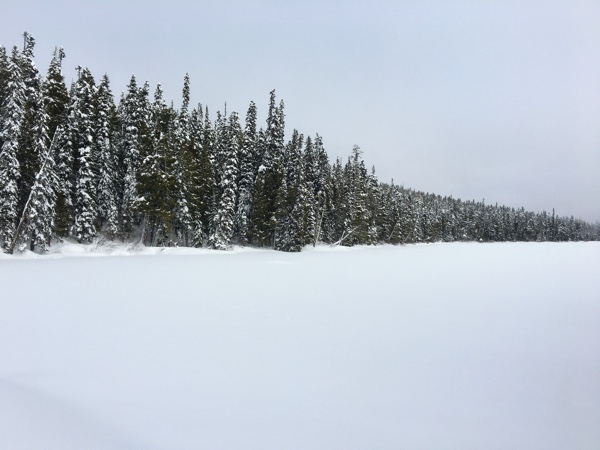 White Pass is 130 miles from Olympia over mostly rural highway, so it was a long, dark drive. We pulled into the ski resort at 8:00 a.m., just in time to watch the sun rise. Few people were at the resort that early, so we had no problem finding a good parking space. Everyone else in our group trickled in over the next half hour, and by 9:00 a.m., we were ready to head out. I joined the slow group, which consisted of three other students and two trip leaders, all women. Our group was assigned the Leech Lake trail, so we headed out around the lake.
White Pass is 130 miles from Olympia over mostly rural highway, so it was a long, dark drive. We pulled into the ski resort at 8:00 a.m., just in time to watch the sun rise. Few people were at the resort that early, so we had no problem finding a good parking space. Everyone else in our group trickled in over the next half hour, and by 9:00 a.m., we were ready to head out. I joined the slow group, which consisted of three other students and two trip leaders, all women. Our group was assigned the Leech Lake trail, so we headed out around the lake.
As usual, it didn’t take me long to fall behind. One of the leaders and I both fell behind, despite my working my ass off to keep up with everyone else. The group stopped while the front leader explained something, and as soon as we caught up, they were off again. I missed whatever she had to say. A few minutes later, they stopped again while she explained something. We caught up, and they were off. Again, I missed whatever she had to say.
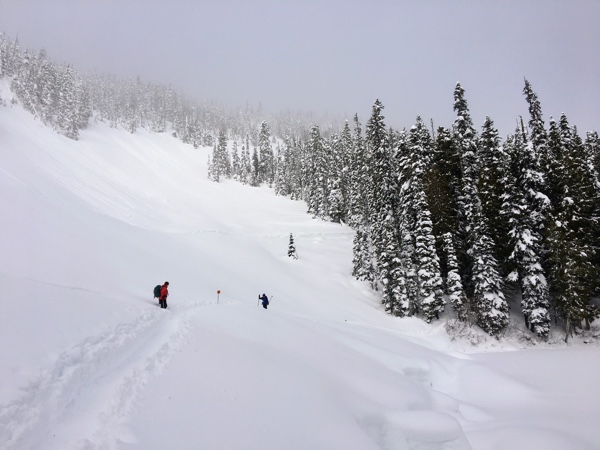 Finally, when they stopped for a third time, the two of us laggers shouted that we couldn’t hear. She paused, and when we caught up, I explained to her that the rest of the group was going so fast that we hadn’t been able to catch up to ask her to slow down.
Finally, when they stopped for a third time, the two of us laggers shouted that we couldn’t hear. She paused, and when we caught up, I explained to her that the rest of the group was going so fast that we hadn’t been able to catch up to ask her to slow down.
From then on, the group maintained a pace we could all manage. We practiced falling down and getting back up, trail etiquette, breaking trail, recognizing hazards, and avalanche awareness. I enjoyed snowshoeing with the group, especially since I’ve never had anyone to snowshoe with. We tromped around the lake for a couple of hours and then headed back to the Nordic yurt to meet up with the rest of the group and have lunch.
After lunch, we all snowshoed up a steep slope to do some avalanche training. The two instructors dug snow pits and demonstrated the extended block tests and then had the group search for an avalanche beacon they’d hidden in the snow. Because of the steep slope angle and the depth of the snow, I opted out of this exercise and headed back down the trail. If it had been a real situation, I would not have hesitated to look for an avalanche victim, but in a practice situation, I am not going to put my $40,000 knees at risk.
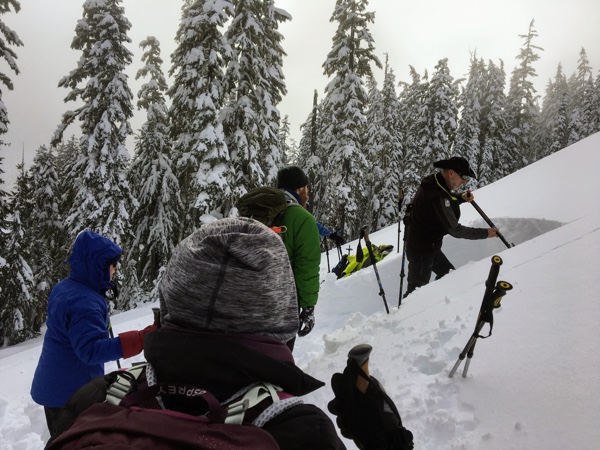 I found this course to be very informative, and I’m glad I took it. Although I have some snowshoeing experience, the class exposed me to different types of snowshoes and poles. I hadn’t really paid any attention to this before. I had purchased a new pair of snowshoes a few weeks previously at an REI garage sale because I’d wore out my first pair last winter. I had thought about buying another pair on eBay for $50 as I had my last pair, but honestly, I was afraid I’d be embarrassed for wearing cheapie snowshoes. I don’t mind cheapie tents and backpacks, but snowshoes are a little different.
I found this course to be very informative, and I’m glad I took it. Although I have some snowshoeing experience, the class exposed me to different types of snowshoes and poles. I hadn’t really paid any attention to this before. I had purchased a new pair of snowshoes a few weeks previously at an REI garage sale because I’d wore out my first pair last winter. I had thought about buying another pair on eBay for $50 as I had my last pair, but honestly, I was afraid I’d be embarrassed for wearing cheapie snowshoes. I don’t mind cheapie tents and backpacks, but snowshoes are a little different.
So, when I saw REI was having a garage sale, I decided to look there first. Sure enough, they had a half dozen in the sale, and I was fortunate enough to grab the one pair in my size–MSR Revo Explorers, normally $220 a pair, marked down to $140. They had been used once and were returned because the previous owner “didn’t like them.” I didn’t realize it at the time, but MSRs are designed here in the Pacific Northwest specifically for snowshoeing in mountainous terrain. My previous pair were tubular frames with less aggressive crampons, more suitable for flatland, which is exactly where I had been using them. So, stupid pride caused me to buy the right snowshoes for my new environment.
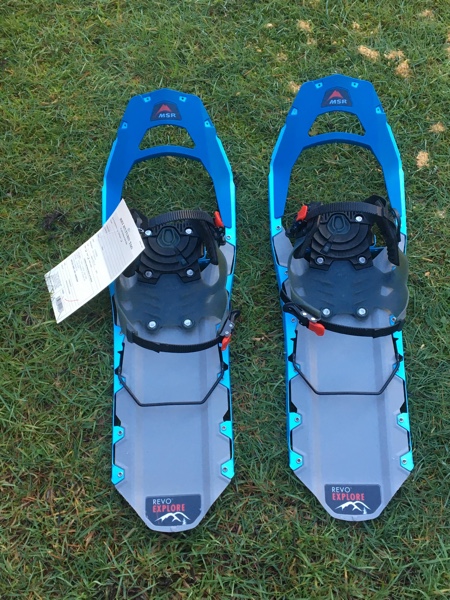 My experience in this class has changed my opinion of the Mountaineers. Although I will continue to question every trip leader before signing up for an event and I will encourage everyone else to do so, as well, I would like to participate in more events. However, I do want to note that even though I went with the “slow” group on the field trip, their pace was still too fast and I still had to struggle to keep up until I finally had a chance to catch up and bring it to their attention. I don’t understand failing to notice part of the group continually falling behind, but they did slow down when asked. But, I had fun, and I learned a lot. It was a good experience.
My experience in this class has changed my opinion of the Mountaineers. Although I will continue to question every trip leader before signing up for an event and I will encourage everyone else to do so, as well, I would like to participate in more events. However, I do want to note that even though I went with the “slow” group on the field trip, their pace was still too fast and I still had to struggle to keep up until I finally had a chance to catch up and bring it to their attention. I don’t understand failing to notice part of the group continually falling behind, but they did slow down when asked. But, I had fun, and I learned a lot. It was a good experience.
For more information about avalanche awareness, check out REI’s website. REI also offers avalanche awareness classes; check out your local REI classes and events listings.